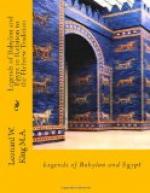LECTURE II — DELUGE STORIES AND THE NEW SUMERIAN VERSION
In the first lecture we saw how, both in Babylonia and Egypt, recent discoveries had thrown light upon periods regarded as prehistoric, and how we had lately recovered traditions concerning very early rulers both in the Nile Valley and along the lower Euphrates. On the strength of the latter discovery we noted the possibility that future excavation in Babylonia would lay bare stages of primitive culture similar to those we have already recovered in Egyptian soil. Meanwhile the documents from Nippur had shown us what the early Sumerians themselves believed about their own origin, and we traced in their tradition the gradual blending of history with legend and myth. We saw that the new Dynastic List took us back in the legendary sequence at least to the beginning of the Post-diluvian period. Now one of the newly published literary texts fills in the gap beyond, for it gives us a Sumerian account of the history of the world from the Creation to the Deluge, at about which point, as we saw, the extant portions of the Dynastic List take up the story. I propose to devote my lecture to-day to this early version of the Flood and to the effect of its discovery upon some current theories.
The Babylonian account of the Deluge, which was discovered by George Smith in 1872 on tablets from the Royal Library at Nineveh, is, as you know, embedded in a long epic of twelve Books recounting the adventures of the Old Babylonian hero Gilgamesh. Towards the end of this composite tale, Gilgamesh, desiring immortality, crosses the Waters of Death in order to beg the secret from his ancestor Ut-napishtim, who in the past had escaped the Deluge and had been granted immortality by the gods. The Eleventh Tablet, or Book, of the epic contains the account of the Deluge which Ut-napishtim related to his kinsman Gilgamesh. The close correspondence of this Babylonian story with that contained in Genesis is recognized by every one and need not detain us. You will remember that in some passages the accounts tally even in minute details, such, for example, as the device of sending out birds to test the abatement of the waters. It is true that in the Babylonian version a dove, a swallow, and a raven are sent forth in that order, instead of a raven and the dove three times. But such slight discrepancies only emphasize the general resemblance of the narratives.




